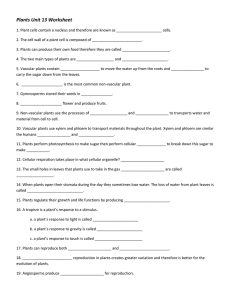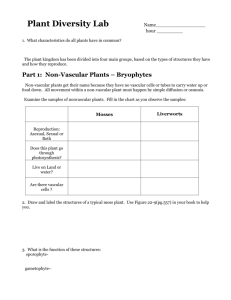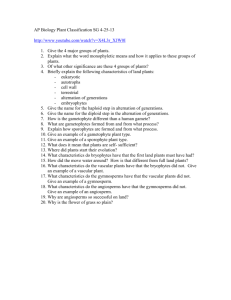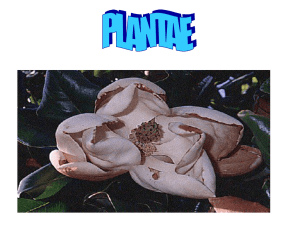Introduction to the Plant Kingdom 1
advertisement
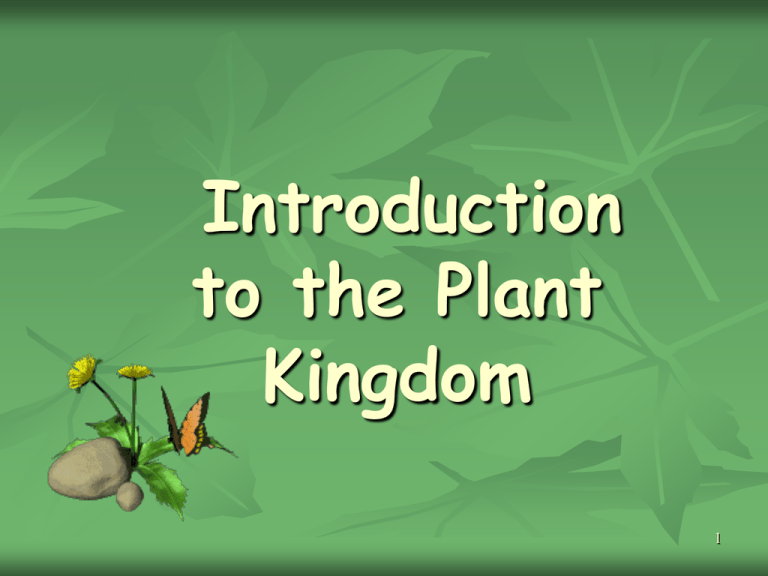
Introduction to the Plant Kingdom 1 Early Ancestors Aquatic to Terrestrial Life 2 Aquatic Ancestor Closest living species to a possible land plant ancestor Group of green algae Called Charyophyceans Chara 3 Algae & Land Plant Similarities Both contain chlorophylls a and b Have chloroplasts with stacks of thylakoids Store starch in plastids Cellulose in cell walls Go through Alternation of Generations life Cycle 4 Aquatic Habitat Terrestrial Habitat 5 Living in Aquatic Environments Plants surrounded by water so don’t dry out Sperm swims to egg Water supports plant Plants stay in upper surface near light Absorb nutrients from the H2O 6 Plant Adaptations to Land Problems: Need minerals Gravity Increase in Height for Light Adaptations for Drier environment Reproduction Solutions: Roots absorb H2O & minerals Lignin & cellulose in cell walls Vascular Transport System Waxy cuticle & stomata with guard cells Pollen containing sperm7 How Are Plants All Alike? 8 Plant Characteristics Multicellular Autotrophic (photosynthesis) Chlorophylls a and b in thylakoid membranes Surrounded by cell walls containing cellulose (polysaccharide) Store reserve food as amylose (starch) 9 Plant Reproduction Alternation of generations life cycle Diploid (2n) sporophyte stage Haploid (1n) gametophyte stage Produce multicellular embryo protected inside multicellular haploid (gametophyte egg sac) tissue 10 Plant Reproduction Diploid (2n) sporophyte stage produces haploid spores by meiosis Haploid spores undergo mitosis to produce gametophyte stage Gametophyte makes gametes (eggs and sperm) 11 Alternation of Generations 2n 1n 1n 12 Plant Divisions 13 Taxonomy Plants are divided into two groups Based on the presence or absence of an internal transport system for water and dissolved materials Called Vascular System Vascular Bundles 14 Nonvascular Plants Do not have vascular tissue for support or conduction of materials Called Bryophytes Require a constantly moist environment Sporophyte stage Gametophyte Stage Moss Gametophytes & Sporophytes 15 Nonvascular Plants Plants can’t grow as tall Cells must be in direct contact with moisture Materials move by diffusion cell-to-cell Sperm must swim to egg through water droplets 16 Nonvascular Plants Includes mosses (Bryophyta), liverworts (Hepatophyta), and hornworts (Antherophyta) Liverworts Hornworts 17 Non-Vascular plants that do not have tubes to carry water up the plant or tubes to carry food made in the leaves down the plant Examples: mosses liverworts ferns hornworts Non-Vascular Moss Non-Vascular Liverwort Non-Vascular Fern Non-Vascular Hornwort Vascular Plants Also called Tracheophytes Subdivided into two groups -Seedless vascular plants and Seedbearing vascular plants Club Moss 23 Seedless Vascular Plants Includes club moss (Lycophyta), horsetails (Sphenophyta), whisk ferns (Psilophyta), and ferns (Pterophyta) Whisk ferns Horsetails 24 Seed-Producing Vascular Plants Includes two groups – Gymnosperms and Angiosperms Gymnosperms have naked seeds in cones Angiosperms have flowers to attract pollinators and produce seeds 25 Gymnosperms Coniferophyta are known as conifers Includes pine, cedar, spruce, and fir Cycadophyta – cycads Ginkgophyta ginkgo Cycad Ginkgo 26 Gymnosperms Contains the oldest living plant – Bristle cone pine Contains the tallest living plant – Sequoia or redwood 27 Angiosperms Flowering plants Seeds are formed when an egg or ovule is fertilized by pollen in the ovary Ovary is within a flower Flower contains the male (stamen) and/or female (ovaries) parts of the plant Fruits are frequently produced from these ripened ovaries 28 Parts of a Flower Male Parts Female Parts Parts of a Flower Male Parts Female Parts The stamen consists of two parts: the anther and the filament. The filament holds the anther. The anther produces and carries the pollen. Parts of a Flower Male Parts Female Parts The pistil consists of three parts: the stigma, style, and ovary. The stigma is the sticky part that traps and holds the pollen. The style is the tube-like structure that holds up the stigma. The ovary and the ovule are at the bottom of the style. Parts of a Flower Male Parts Female Parts The petals attract pollinators. (bees, hummingbirds, butterflies, for example) Parts of a Flower Male Parts Female Parts The sepals are the green petal-like parts at the base of the flower. Sepals help protect the developing bud. Angiosperms Division Anthophyta Subdivided into two groups – Monocots and Dicots Monocots have parallel veins & flower parts in multiples of 3 Dicots have net-veined leaves with flower parts in multiples of 4’s or 5’s 34 49
